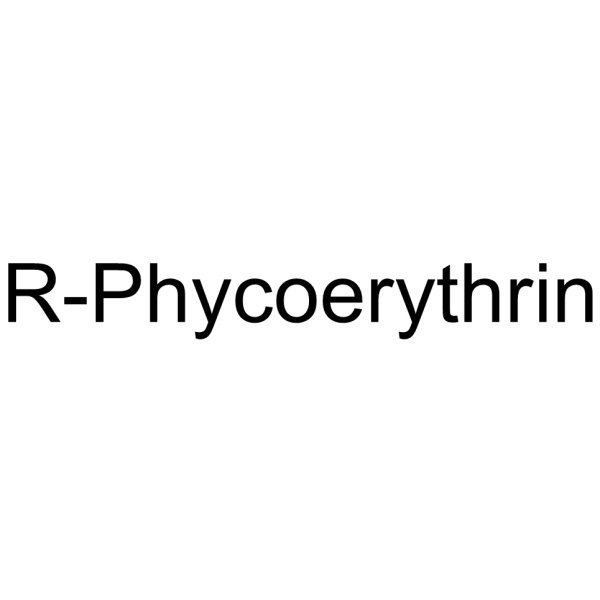R-Phycoerythrin

R-Phycoerythrin structure
|
Common Name | R-Phycoerythrin | ||
|---|---|---|---|---|
| CAS Number | 11016-17-4 | Molecular Weight | N/A | |
| Density | N/A | Boiling Point | N/A | |
| Molecular Formula | N/A | Melting Point | N/A | |
| MSDS | USA | Flash Point | N/A | |
| Symbol |


GHS06, GHS09 |
Signal Word | Danger | |
Use of R-PhycoerythrinR-Phycoerythrin is a phycobiliproteins could be isolated from Heterosiphonia japonica. R-Phycoerythrin is a potent fluorescent probe contains four chromophore-carrying subunits that exhibits extremely bright red-orange fluorescence. (λex=496 nm, λem=578 nm)[1][2]. |
| Name | R-PHYCOERYTHRIN |
|---|---|
| Synonym | More Synonyms |
| Description | R-Phycoerythrin is a phycobiliproteins could be isolated from Heterosiphonia japonica. R-Phycoerythrin is a potent fluorescent probe contains four chromophore-carrying subunits that exhibits extremely bright red-orange fluorescence. (λex=496 nm, λem=578 nm)[1][2]. |
|---|---|
| Related Catalog | |
| References |
| Appearance of Characters | ammonium sulfate suspension |
|---|---|
| Storage condition | 2-8°C |
| Symbol |


GHS06, GHS09 |
|---|---|
| Signal Word | Danger |
| Hazard Statements | H301 + H311-H411 |
| Supplemental HS | Contact with acids liberates very toxic gas. |
| Precautionary Statements | P273-P280-P301 + P310 + P330-P302 + P352 + P312-P391-P501 |
| Personal Protective Equipment | Eyeshields;Gloves |
| Hazard Codes | T+,N,T |
| Risk Phrases | 46-5-26/27/28-32-51/53-23/24/25-24/25 |
| Safety Phrases | 53-36/37/39-45-61-60-36/37-28 |
| RIDADR | UN 3077 9/PG 3 |
| WGK Germany | 3 |
|
Direct differentiation of A-ring single attachment versus A- and D-ring double attachment of phycoerythrobilin chromophores to phycobiliproteins using MALDI mass spectrometry.
J. Mass Spectrom. 48(2) , 187-92, (2013) Bilin chromophore attachment to phycobiliproteins is an enzyme-catalyzed post-translational modification process. Bilin-lyases attach a bilin chromophore to their cognate protein through a thioether b... |
|
|
Salinity impacts photosynthetic pigmentation and cellular morphology changes by distinct mechanisms in Fremyella diplosiphon.
Biochem. Biophys. Res. Commun. 433(1) , 84-9, (2013) Fremyella diplosiphon is a freshwater cyanobacterium that exhibits complementary chromatic adaptation (CCA), which allows the organism to alter its pigmentation and cellular morphology to maximally ha... |
|
|
A minimal phycobilisome: fusion and chromophorylation of the truncated core-membrane linker and phycocyanin.
Biochim. Biophys. Acta 1817(7) , 1030-6, (2012) Phycobilisomes, the light-harvesting antennas in cyanobacteria and red algae, consist of an allophycocyanin core that is attached to the membrane via a core-membrane linker, and rods comprised of phyc... |
| MFCD00081950 |